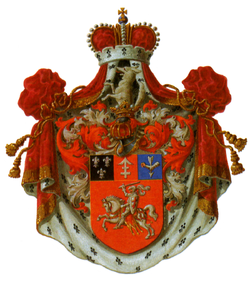Sapieha family

Princely arms of the family (1858–59)
|
|
| Ethnicity | Polish, Lithuanian, Ruthenian |
|---|---|
| Current region | Poland, Lithuania, Belarus |
| Members |
Lew Sapieha Eustachy Sapieha |
| Estate |
Sapieha Palace in Warsaw Sapieha Palace in Lviv Sapieha Palace in Vilnius Ruzhany Palace |
Sapieha (Belarusian: Сапега; Lithuanian Sapiega) is a Polish princely (magnate) family of Lithuanian and Ruthenian origin, descending from the medieval boyars of Smolensk. The family acquired great influence and wealth in the Polish–Lithuanian Commonwealth during the 16th century.
Regarding the ancestry of the Sapieha family, the first confirmed records date back to the 15th century, when Semen Sopiha (Belarusian: Сямён Сапега) was mentioned as a writer (scribe) of the then King of Poland and Grand Duke of Lithuania, Casimir IV Jagiellon (Polish: Kazimierz IV Jagiellończyk) for the period of 1441–49. Semen had two sons, Bohdan and Iwan.
The creator of the fortune and power of the Sapieha family was the Court and Great Chancellor and Great Hetman of Lithuania, Lew Sapieha.
On 14 September 1700, Michał Franciszek Sapieha obtained the title of Prince from Emperor Leopold I. The title became extinct upon his death on 19 November 1700. That year, the family lost its dominant position in the Grand Duchy as a result of its defeat in the Lithuanian Civil War. In 1768, members of the Sapieha family obtained recognition of the princely title from the Polish Sejm. After the partitions of Poland, the family appeared in the list of persons authorised to bear the title of Prince of the Kingdom of Poland in 1824. The title was recognised in Austria in 1836 and 1840, and in Russia in 1874 and 1901. In 1905, the family obtained the qualification of Serene Highness in Austria.
...
Wikipedia
